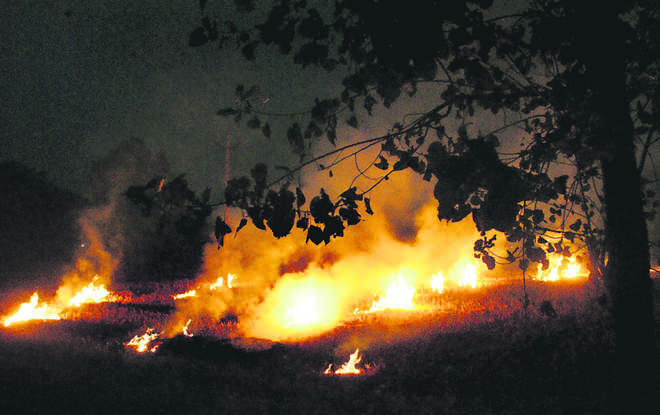
The period between October 15 and November 15 is considered critical as most farmers harvest their paddy crop at this time and high levels of PM10 are witnessed.
Aman Sood
Tribune News Service
Patiala, November 17
To get rid of paddy stubble in their fields, farmers resorted to fires and the impact was visible in urban areas with air quality dropping from poor to very poor category. However, the compilation of October figures from the rural air monitoring stations shows that villagers were the affected more due to high concentration of PM10 (Particulate Matter up to 10 micrometers in size).
Data procured from the Punjab Pollution Control Board (PPCB) and compiled by The Tribune shows that the 24 air monitoring devices in Punjab villages found that barring a handful of villages, a majority of them had very high level of PM10 coarse particles in their air. The state has already witnessed over 50,000 farm fires.
The period between October 15 and November 15 is considered critical as most farmers harvest their paddy crop at this time and high levels of PM10 are witnessed. While 0-70 microgram per cubicmetre (µg/m³) of PM10 is considered in good category, any increase from this adds to health ailments.
“The villages’ average for October shows high levels that are dangerous for humans as well as animals. Smoke and particles emanating from farm fires are the biggest reasons and as a result people of rural areas were breathing toxic air with these coarse particles that causes danger to their organs,” say experts.
According to October average PM10 in Punjab villages, Mukandpur village and its nearby residents were breathing 207, in Muktsar’s Marar Kalan village the levels were 178, 164 in Bathinda’s Poohli, in Ludhiana’s Rohila 167 and 165 in Bishanpura village, in Barnala’s Aspal Khurad 136, in Ferozepur’s Lakho Ke Behram 133 and over 100 in many other villages.
Particulate matter (PM) is one of many pollutants that contribute to reduced air quality in Punjab. The concentrations of PM are caused by both human activities and natural occurrences and in Punjab’s case it was more of a man-made disaster. “We take average monthly data from all 24 stations in villages and usually in these months smoke from farm fires is the biggest contributor in Punjab,” says PPCB spokesman Charanjit Singh.
Experts suggest that exposure to these particles can cause a range of health problems, including aggravated cardiac and respiratory diseases such as asthma, bronchitis, emphysema, and various forms of heart disease.
“Children, elderly and people with respiratory disorders are particularly susceptible. Other toxic air pollutants can bind to the PM that is already in the air, creating additional health risks. PM can also harm vegetation, materials and buildings. Further, PM may also accumulate on plant surfaces and leach into soils, increasing a plant’s susceptibility to disease and along with other air pollutants, contributes to reduced visibility and smoggy conditions,” they said.
Average PM10 recorded in Oct
Mukandpur village in Nawanshahr recorded 207, in Muktsar’s Marar Kalan village the levels were 178, 164 in Bathinda’s Poohli, in Ludhiana’s Rohila 167 and 165 in Bishanpura village, in Barnala’s Aspal Khurad 136, in Ferozepur’s Lakho Ke Behram 133. 0-70 microgram per cubicmetre of PM10 is considered in good category, any increase adds to health ailments.
What is PM 10?
The coarse particles are between 2.5 and 10 micrometers (25-100 times thinner than human hair). These cause health effects mostly in the upper respiratory tract.



























